- Bernard Preston homepage
- Starch
- Resistant Starch in Whole Grains
Resistant starch in whole grains
The resistant starch in whole grains helps with weight loss and insulin-resistance; it does this in part by modifying the friendly bacteria in the gut.
In an increasingly obese world the number of Americans dieting in the past year has risen dramatically; up from 38% five years ago to over half of the adult population today. Alas few are succeeding and many continue to put on weight; and are becoming very angry and depressed in the process.
There are many reasons driving this obesity pandemic, far worse than that caused by viruses; it's the cause of the degenerative conditions like diabetes, cardiovascular disease and fatty liver. A major factor is the extraction of fibre and "resistant starch" from the food found typically in the grocery store.
Two types of resistant starch (RS)
There are in fact five types but we shall focus on only two; a third is not commonly eaten and the others constitute ultra-processed foods and should be shunned.
- Resistant starch in unprocessed whole grains and legumes.
- Retrograded starch that has been allowed to cool overnight; and can be reheated.
- Fava beans that have not been skinned contain 47% resistant starch.
- Green lima beans have a high amylose content which is more resistant to enzyme action.
- True wholegrain bread contains large amounts of resistant starch that is only slowly turned into glucose for absorption in the small intestine; much passes through to the colon.
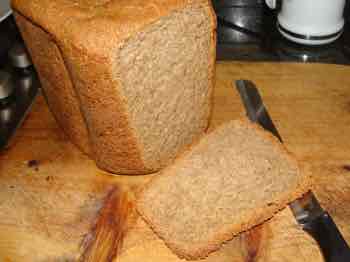 100% wholegrain bread
100% wholegrain bread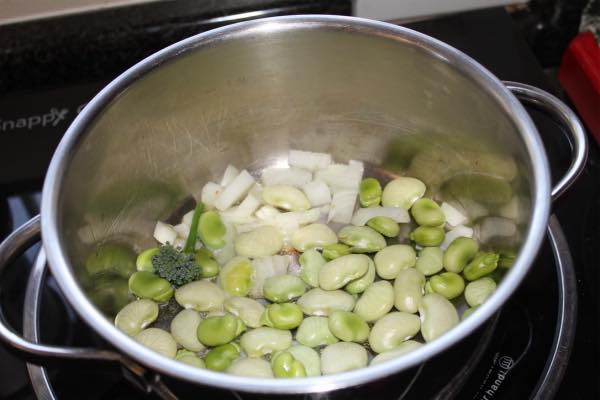 Green lima and fava beans
Green lima and fava beansBoth resistant and retrograded starches produce far less glucose which would have been digested and absorbed in the small intestine but instead pass through to the colon; they are fermented by the friendly flora producing instead highly beneficial "short-chain fatty acids."
So they behave in many ways like the fibre in our diet that also does not yield glucose that would raise blood sugar.
Glucose from carbohydrate is in fact our chief source of energy but we get more than enough of it. Chronic over-consumption of refined starches is the chief causes of type 2 diabetes, fatty liver disease and obesity; and sugar too obviously.
A registered dietician gives an excellent presentation of resistant and retrograded starches at SELF[2].
Quinoa is another option often touted by dieticians. It has several excellent features; for example, like broad beans it contains all the amino acids so it's a "complete" protein like eggs, cheese and meat. What concerns me is that it is "washed" to remove the bitter coating; and that the cooking time is only 10 to 15 minutes. My suspicions are that it is not a true whole grain. However at 54 is has a low GI.
 The starch in corn grits that is cooled overnight retrogrades
The starch in corn grits that is cooled overnight retrogradesIs polenta a true whole grain?
As with most grains there is a certain amount of deceit in the labelling. One is never quite certain how much of the bran and germ have been extracted by "sharp" millers; that's where the real value lies and it can be sold for a greater profit as animal feed.
Polenta is really more finely ground yellow grits; that means it has a higher GI, over 100 in some cases when ultra-processed or precooked[3].
Best is to look to the recommended cooking time; if it's less than 30 minutes then be suspicious.
True stone ground polenta is made usually from yellow corn; and will contain about 4 grams of fibre per cup. That is substantial on your way to the recommended dietary allowance of about 35g. All the germ with many important vitamins, minerals and phytonutrients will be present too.
As with all grains it's best to chill your polenta overnight so that the carbs can retrograde. Reheat it the next morning with milk and some added fat to help with the absorption of the beta-carotene, lutein and zeaxanthin; they all protect us from blindness both as children from a vitamin A deficiency and from adult-onset macular degeneration.
Polenta is often cooked with a vegetable stock and those with a truly nutritious bent can enjoy it with butter and even cream-cheese; but are you genuinely getting all that fiber from salads, legumes and true whole grains?
Dieting rule No. 1
Only make changes to your diet that you are prepared to continue with for the rest of your life; anything less is blowing in the wind and doomed to fail.
- Could you start eating legumes daily? We prefer those that are green to the dried kinds but lentils too are excellent. Chickpeas need to be cooled and retrograded.
- Could you give up commercial bread made from refined flour for ever and eat only wholegrain?
- Could you start cooking your starches like pasta, potato and grits the day before; allowing them to cool in the fridge overnight?
- Would you consider baking your own sourdough wholegrain bread several times a week?
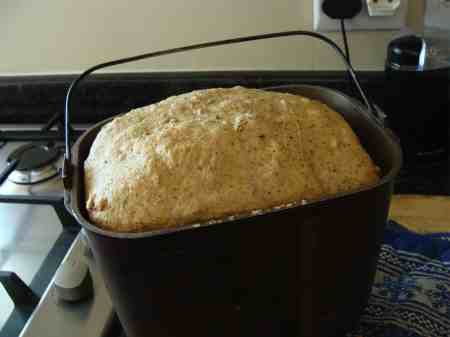 It takes just five minutes to mix the dough
It takes just five minutes to mix the doughOne large bagel for breakfast and two slices of white bread for lunch amounts to seven servings of refined flour with a 47% greater risk of stroke, according to research in BMJ[1].
Microbiome
The friendly bugs in the intestines known as the microbiome play an absolutely vital role in weight loss, reducing fat absorption in the gut and controlling inflammation in the body. But they can only flourish if fibre and resistant starch reach them in the colon.
There is no other safe, inexpensive and successful way to lose weight permanently.
You could get that resistant starch from a dietary supplement. Why not rather just enjoy it in your food? Researchers have found that it will increase the friendly gut microbiota, particularly the Bifido and Lactobacillus species; they then outnumber and help overwhelm any opportunistic pathogens that might present themselves[1].
High fat diets
High fat diets remain controversial with researchers divided on the benefits when it comes to weight loss and health outcomes.
Some research certainly shows that a high resistant-starch diet with low fat had an immediate impact on weight loss; but little effect on high blood lipids. All the fibre slows gastric emptying and sends messages to the brain about satiety.
- The feeling of fullness after eating is often described as satiety.
It is highly likely that the source may be the key; fruit oils (olive and avocado), seed lipids and animal fat.
The ketogenic diets demand very low carbohydrate from any source coupled with high fat mostly from animals; that deals with hunger. The lipids also provide satiety; and increase the absorption of important phytonutrients.
Dieting rule number two
Only make changes to your diet that you are prepared to continue with for the rest of your life; anything less is blowing in the wind and doomed to fail.
Research
Researchers using a powerful double-blinded intervention gave two groups of individuals either 40 grams of resistant starch or a placebo control carb for 8 weeks. After a month long washout period they crossed over to the other prepackaged sachets.
1. Weight loss
The resistant starch (RS) group lost on average 2.8kg after the four week trial but the control group none. Fat mass and waist circumference also decreased.
- Repeated loss and gain of weight may lead to chronic kidney disease.
2. Insulin resistance
The RS group had a significant drop in insulin concentrations; but the Control Starch (CS) group showed no change compared to baseline values.
There was also a significant improvement in the insulin sensitivity.
3. Chronic inflammatory response
Levels of pro-inflammatory cytokines were significantly lower in the resistant starch group as compared to the control.
Intestinal permeability was significantly lowered indicating a restoration of the gut barrier in the RS group.
4. Excreted fats
The RS group had significantly higher levels of excreted cholesterol, triglycerides and fatty acids in the faeces compared to the Control Starchers.
5. Gut microbiota
There were distinct changes in the gut microbiota in both the RS and CS groups after the dietary interventions were initiated.
6. Abdominal discomfort
Those enjoying resistant starch in whole grains have far less abdominal discomfort and passing the stool becomes easier; especially if they are having sourdough bread.
Reduce total or just refined starch?
There are very definitely two schools of thought in regard to restricted starch consumption for weight loss. One group looks to putting the body into ketosis by reducing all carbs to less than 20 grams per day. That means virtually no grains, whole or otherwise; or legumes. Most fruit except for berries is also restricted.
The second school calls for the dropping of all refined carbs but allowing resistant starch in moderate amounts. They believe this is more sustainable long term. Weight loss will be slower but is less likely to return with a vengeance when we return to eating the staff of life for example, which we may feel we cannot give up for ever; nor need to.
Dieting rule number 3
Only make changes to your diet that you are prepared to continue with for the rest of your life; anything less is blowing in the wind and doomed to fail.
Probiotics
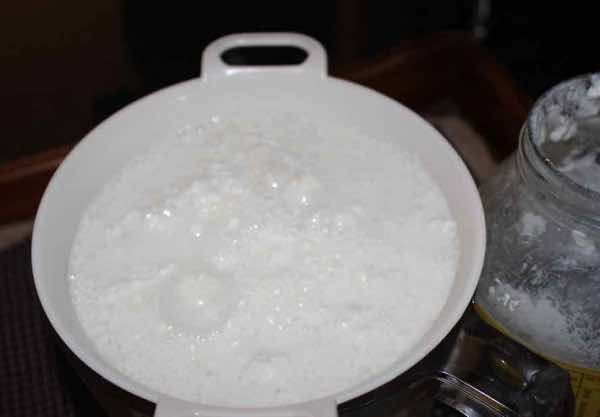 Colander, starter culture and fresh milk
Colander, starter culture and fresh milkIn the healthy tum there is a massive 2kg of friendly bacteria, viruses and yeast cells; and other lesser known creatures. However few people eating typical grocery store food, subjected to antibiotics both in their food and as treatment come close to that figure.
Two factors are important; the total mass of bugs and their diversity. For this reason a probiotic food such as kefir or sauerkraut, both containing many different species is preferable to a supplement supplying only a limited range.
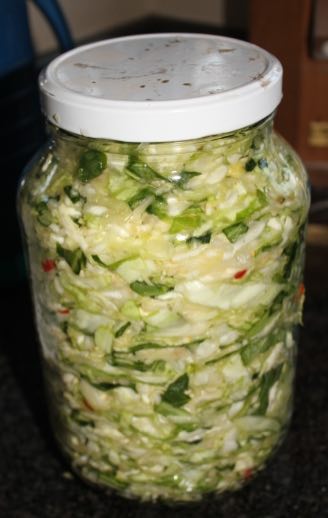

Where to start
Keeping in mind dieting rule no.1 choose either to increase the amount of resistant starch in your food; or start to avoid all refined carbs, keeping cakes and puddings for high and holy days only. It's a matter of personal choice.
Resistant starch in whole grains which has been allowed to retrograde overnight and then reheated to make a porridge gives you the double benefit.
Wholegrain corn has a particularly large amount (25%) of resistant starch.
We now rather choose yellow cornmeal grits, also known as polenta for its beta-carotene content; it helps prevent blindness in both children and adults. It's also cheaper, has more protein and less starch; it is not fattening.
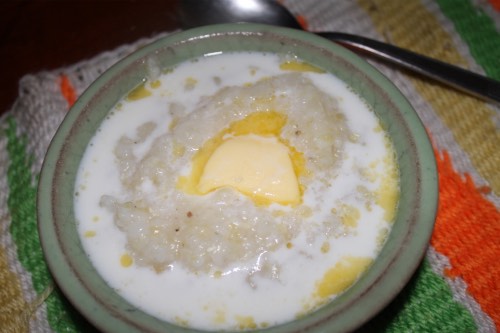
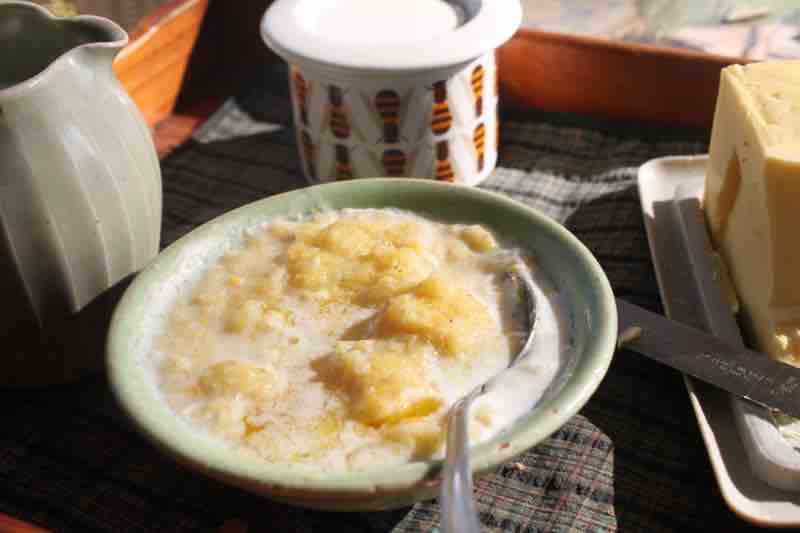
Dieting rule number 4
Resistant starch in whole grains
Resistant starch in whole grains is not digested to form glucose. It does not contribute to weight gain.
In fact those eating 40 grams of resistant starch lost 2.6kg over two months.
When browsing use right click and "Open Link in New Tab" or you may get a bad gateway signal.
frequently asked questions
Do whole grains have resistant starch?
Yes true whole grains certainly do have resistant starch provided that they are not refined. Millers usually remove all or most of the bran which is where the fibre is; and the germ which contains the fat and about a quarter of the protein.
They stimulate the glands in the stomach and small intestine that slow gastric emptying, stimulate the beta-cells in the pancreas and send messages to the brain providing satiety.
Starch granules within the bran limit the accessibility of the enzyme amylase that digests the carbs.
Amylose and the fat from the germ form a complex that resists the enzymatic digestive action.
What foods are highest in resistant starch?
Whole grains, legumes and seeds are highest in resistant starch; new potatoes rank well too. But they do have to be chewed thoroughly which takes more time; and longer to cook.
The joy of resistant starches is that you can banish that nasty word "diet" from your thinking for ever. Did you know that globally 45% of folk will today be focusing on losing weight?
Newsletter
Our newsletter is entitled "create a cyan zone" at your home, preserving both yourself and Mother Earth for future generations; and the family too, of course. We promise not to spam you with daily emails promoting various products. You may get an occasional nudge to buy one of my books.
Here are the back issues.
- Lifestyle and ideal body weight
- What are ultra-processed foods?
- Investing in long-term health
- Diseases from plastic exposure
- Intensive lifestyle management for obesity has limited value
- A world largely devoid of Parkinson's Disease
- The impact of friendly bacteria in the tum on the prevention of cancer
- There's a hole in the bucket
- Everyone is talking about weight loss drugs
- Pull the sweet tooth
- If you suffer from heartburn plant a susu
- Refined maize meal and stunting
- Should agriculture and industry get priority for water and electricity?
- Nature is calling
- Mill your own flour
- Bake your own sourdough bread
- Microplastics from our water
- Alternative types of water storage
- Wear your clothes out
- Comfort foods
- Create a bee-friendly environment
- Go to bed slightly hungry
- Keep bees
- Blue zone folk are religious
- Reduce plastic waste
- Family is important
- What can go in compost?
- Grow broad beans for longevity
- Harvest and store sunshine
- Blue zone exercise
- Harvest and store your rainwater
- Create a cyan zone at your home
Did you find this page interesting? How about forwarding it to a friendly book or food junkie? Better still, a social media tick would help.
- Bernard Preston homepage
- Starch
- Resistant Starch in Whole Grains
Address:
56 Groenekloof Rd,
Hilton, KZN
South Africa
Website:
https://www.bernard-preston.com